Motorola Droid 3 Review - Third Time's a Charm
by Brian Klug on July 30, 2011 12:01 AM ESTPerformance Analysis
The next stop on our trip through the Droid 3 is of course its SoC, which is a TI OMAP 4430. This is our first formal encounter with OMAP4430 in a real, live shipping phone. Well, that’s not entirely true - we have an LG Optimus 3D in the queue as well which we’ll be talking about later.
The OMAP 4430 is based on two ARM Cortex A9s, each running at up to 1.0 GHz and with 1 MB of shared L2 cache. Unlike Tegra 2, however, OMAP 4 includes the ARM Media Processing Engine (MPE) instead of just the default A9 FPU, and thus allows OMAP 4 to execute NEON (SIMD) in addition to just normal VFP and VFPv3 instructions. It’s easiest to illustrate the difference simply by showing what looking at /proc/cpuinfo yields on each SoC:
OMAP 4: Features : swp half thumb fastmult vfp edsp thumbee neon vfpv3
Exynos: Features : swp half thumb fastmult vfp edsp neon vfpv3
Tegra 2: Features : swp half thumb fastmult vfp edsp vfpv3 vfpv3d16
MSM8260: Features : swp half thumb fastmult vfp edsp thumbee neon vfpv3
OMAP 3: Features : swp half thumb fastmult vfp edsp neon vfpv3
Careful readers will note that the other interesting differentiator is thumbee support, which to my knowledge isn’t used in Android currently. NEON, however, definitely is throughout the Android OS, including places like Skia (for drawing 2D graphics, text, and images), Chrome (web browsing, both for rendering, page layout, and the all-important V8 JavaScript engine), and Surfaceflinger (Android’s window system and compositor). Each Cortex A9 has an MPE onboard.
There’s also two Cortex-M3s inside OMAP4430, which do double duty for for OMAP4’s Imaging SubSystem (ISS). In OMAP4, that ISS comprises image signal processing (ISP) functions such as autofocus, exposure, white balance, and acting as a front end interface to any and all cameras, and secondly still image processing (SIMCOP) which includes functions such as actually coding the image out to JPEG, correction for lens distortion, and any noise filtering from running the sensor at a high ISO. One of the M3s handles SIMCOP, the other can divide itself between managing the realtime OS running both, the ISP functions for camera, or do some duty managing the display subsystem. Those M3s are also clock gated in sleep modes.
The next important part of the equation is OMAP4430’s GPU, which is a PowerVR SGX 540. What sets the SGX 540 in OMAP4430 apart from the other SGX 540’s we’ve seen to date (such as the one in Samsung’s Hummingbird S5PC110 SoC) is that it runs at a higher clock of 304 MHz compared to Hummingbird’s ~200 MHz. Back when OMAP 4470 was announced, I made this table:
| TI OMAP 4xxx SoC GPU Comparison | |||||||||
| OMAP4430 | OMAP4460 | OMAP4470 | |||||||
| GPU Used | PowerVR SGX540 | PowerVR SGX540 | PowerVR SGX544 | ||||||
| Clock | 304 MHz | 384 MHz | 384 MHz | ||||||
Alongside it I re-published the table that Anand put together back for our Tegra 2 piece with a more concise breakdown. We can see that though the GPU is still an SGX 540, increasing those clocks makes an obvious positive difference in performance.
| Mobile SoC GPU Comparison | |||||||||
| PowerVR SGX 530 | PowerVR SGX 535 | PowerVR SGX 540 | PowerVR SGX 543/544 | PowerVR SGX 543/544MP2 | GeForce ULP | Kal-El GeForce | |||
| SIMD Name | USSE | USSE | USSE | USSE2 | USSE2 | Core | Core | ||
| # of SIMDs | 2 | 2 | 4 | 4 | 8 | 8 | 12 | ||
| MADs per SIMD | 2 | 2 | 2 | 4 | 4 | 1 | ? | ||
| Total MADs | 4 | 4 | 8 | 16 | 32 | 8 | ? | ||
| GFLOPS @ 200MHz | 1.6 GFLOPS | 1.6 GFLOPS | 3.2 GFLOPS | 6.4 GFLOPS | 12.8 GFLOPS | 3.2 GFLOPS | ? | ||
| GFLOPS @ 300MHz | 2.4 GFLOPS | 2.4 GFLOPS | 4.8 GFLOPS | 9.6 GFLOPS | 19.2 GFLOPS | 4.8 GFLOPS | ? | ||
Hummingbird's SGX 540 thus gets around 3.2 GFLOPS, whereas the higher clocked SGX 540 in OMAP4430 is appropriately around 4.8 GFLOPS.
First up is Linpack which now includes a multithreaded test alongside its single threaded test. There was originally some debate internally about whether this version of linpack from the Android market was using NEON or just VFP, the results now speak for themselves, it’s entirely just VFP.
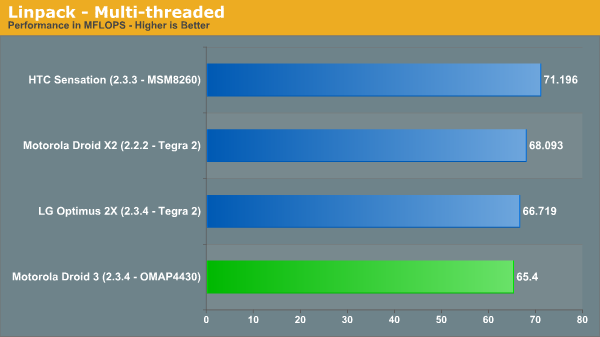
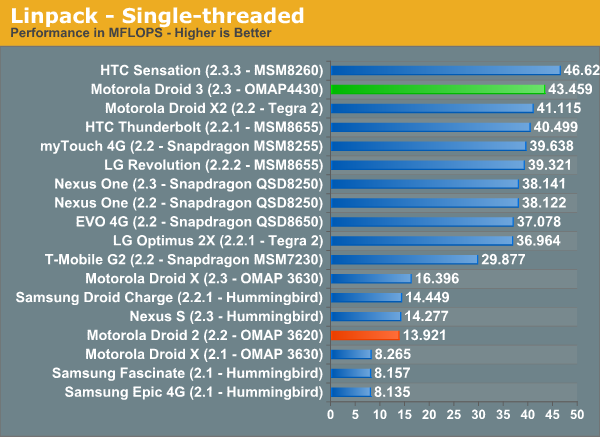
Next are RightWare’s Basemark ES 2.0 which is the latest version of the ever popular 3DMark Mobile ES 2.0, itself an industry standard. The test has two main tests and then a variety of subtests, and Adreno 220 maintains a lead here over the faster SGX 540, but we can see already how much that extra ~100 MHz advantage helps the Droid 3 over the Droid Charge’s Hummingbird (A8 + SGX 540 at 200 MHz). We run at the same VGA resolution here so the results are comparable despite the different display sizes.
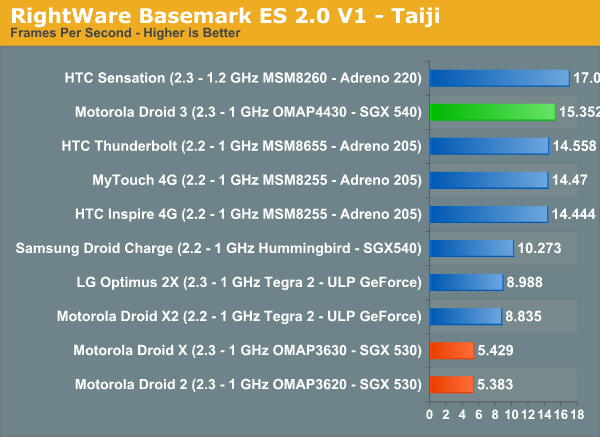
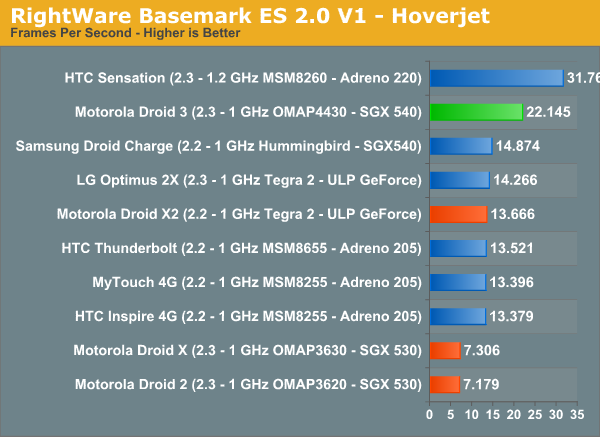
The ever popular GLBenchmark 2.0 is also an industry standard and a regular fixation in our smartphone benchmarking section, and the Droid 3 results mirror what we saw both way back when the device popped up online in the results browser and our initial testing two weeks ago with the phone. GLBenchmark runs in full screen mode, so keep in mind the qHD versus WVGA discrepancy when comparing results. We can easily again see that the higher clocked OMAP4430 SGX 540 changes things up nicely.
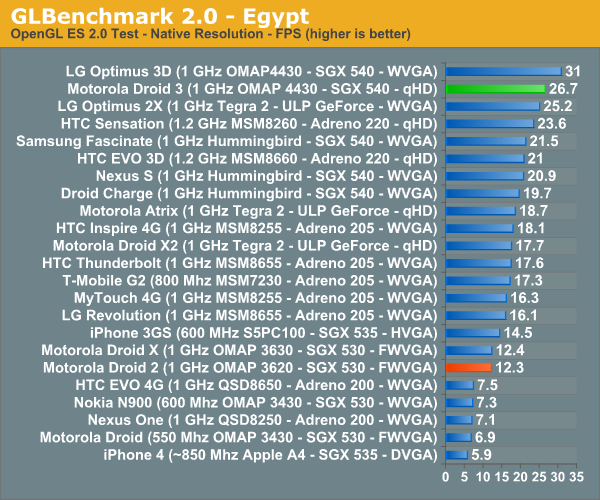
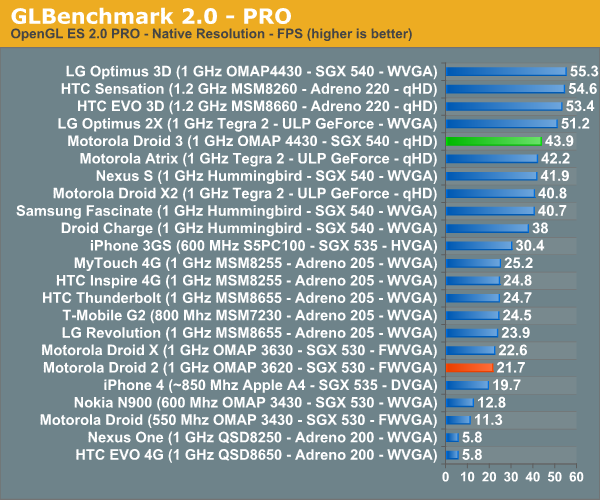
Next up is what started it all for us, the Quake 3 Android port “kwakk3” which is starting to show its age and is basically at the FPS cap on newer devices with newer GPUs. We’ve kept it around for the Droid 3 however just to illustrate how quickly things like this have gone from being almost unplayable a year ago to fluid on modern hardware. Anand keeps saying hyper Moore’s law, and this is just one more data point you can point at as supporting that hypothesis.
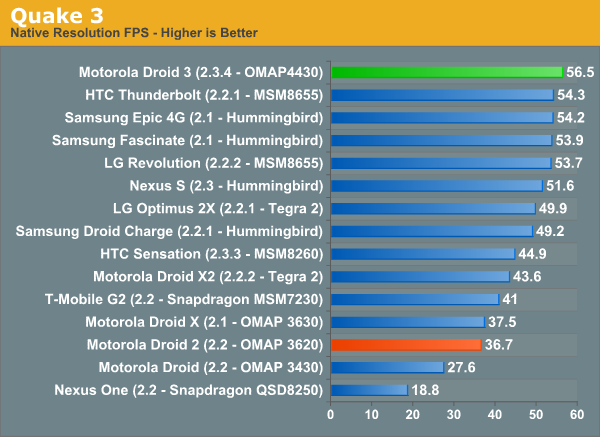
Finally are the two web benchmarking suites, SunSpider 0.9 and RightWare’s Browsermark. We’re running 0.9.1 and will migrate to that soon, but for now the results from 0.9 are still comparable. Remember that V8 does have some NEON codepaths, so we do see OMAP4 pull ahead of Tegra 2 just by a sliver on both tests.
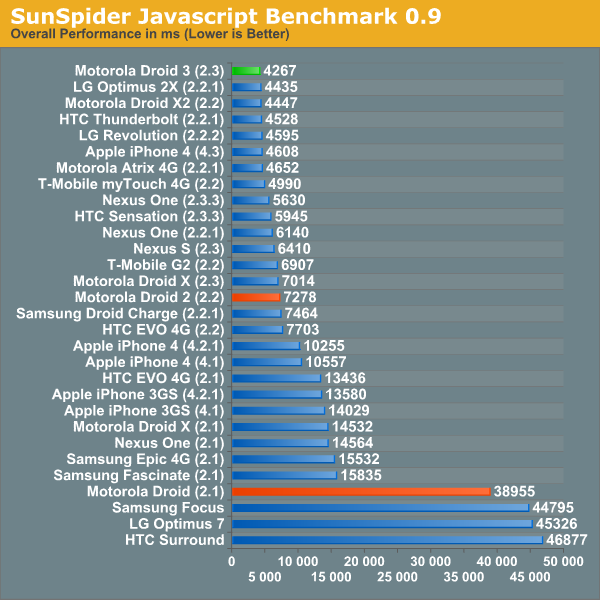
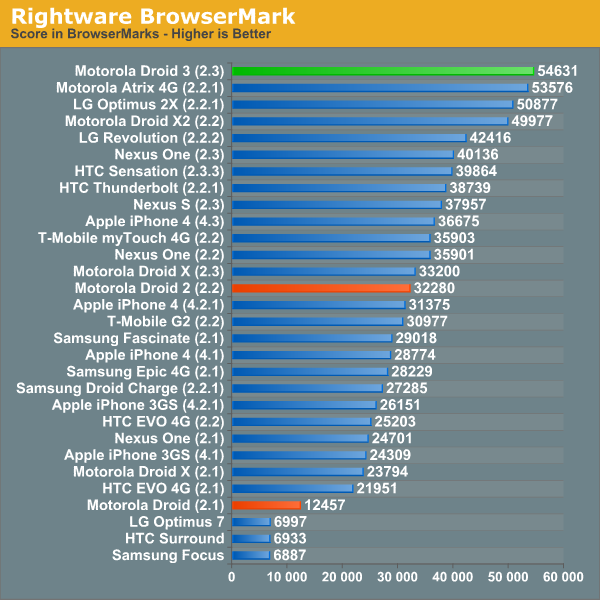
We’re going to start reporting Qualcomm’s new Vellamo benchmark results after we further understand all of its tests and how it calculates results, but we’re running it silently on devices. Until then however, browser scrolling performance (one of the things it does purport to gauge) is still probably the largest and most perceptible performance issue.
I’ve put together a short comparison video showing the Droid 3 alongside a Droid X. I don’t have a Droid 2 on hand anymore, but the X is a decent facsimile both because it has the same resolution as the Droid 2, is running Android 2.3.3 (which the Droid 2 has yet to get but will shortly) and still is based on a 1 GHz OMAP3 (3630 vs 3620).



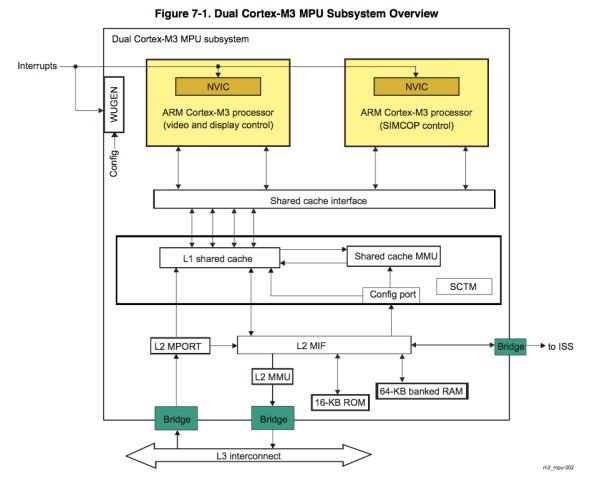








84 Comments
View All Comments
Myrandex - Monday, August 1, 2011 - link
5th row keyboard looks very nice. I did compare one in the store to my Touch Pro 2, and unfortunately I still have to side with the touch pro 2. I tried typing out a sentence and the button size of the touch pro 2 just seemed to reign supreme. It is in the right direction though!Jason Cook
Johnmcl7 - Monday, August 1, 2011 - link
That sounds promising, if they're going to make a Chinese version they may produce an EU version as well given they're producing the hardware anyway.John
aggiechase37 - Tuesday, August 2, 2011 - link
I have the D3. Couple things:1. Gingerbread keyboard does NOT come preinstalled, nor does Angry Birds.
2. I have issues with lag coming back to the homescreen. This is especially persistent with the camera app
3. I also have issues with framerate drops swiping through homescreens and the app drawer. Minor, but noticeable. Hardly as fluid as Anandtech boasts.
4. Something should be said about the screen being much more view-able in direct sunlight, moreso than any screen I've seen so far.
5. Camera lowlight conditions are considerably improved over D3's predecessors.
6. There are issues with the led flash causing a blue tint when snapping pics with NO light, like utter darkness. But seriously who does that?
7. 3rd party launchers are not compatible with Moto's widgets.
8. Moto's launcher eats 40mb's of RAM, seems a little excessive.
9. Task killer included on the phone. Is Moto insane???
relativityboy - Thursday, August 4, 2011 - link
I ordered one of these the day they came available. Coming from a rooted, very customized CM7 D1 I was a little underwhelmed. While there's no question the D3 is capable of more at the limit my D1* felt good in the hand. I don't care for the hard edges of the D3.
* had excellent performance (I lucked out - low voltage ChevyNo1 kernel @ 1.1Ghz). With swap and a fast SD chip I didn't have the launcher reloading all the time.
* had very good battery life (1.5-2 days of med/lite use)
* felt much smaller in the pocket
* actually had better performance in tasks like scrolling the contacts list, and rendering pages in opera/stock browsers
* The radios on the D1 have better reception. I'm not talking about bars on a screen or stats in a test bench. In my office people often complain about dropped calls, poor wifi in the bathrooms(yep), etc. I had no idea what they were talking about until I switched to the D3.
* the touch screen seems less sensitive that on my D1.
--
I'm sure some of my complaints are related to immature software, but things like radio reception shouldn't be related to that. I've had a number of kernel panics, and display resets.
Maybe I got a bad phone, but I'm not sold on the D3.
relativityboy - Friday, August 5, 2011 - link
Today I'm completely frustrated with this piece of bunk. Seriously. This phone is crashing, getting worse, can't get a GPS lock to save it's life.On the bright side, with the kinds of problems I'm having it might not all be buggy software.
amankumar - Thursday, August 4, 2011 - link
want some super cool android HD games to unleash its potential, here's the link:http://nitin-xyz.blogspot.com/2011/07/free-and-ful...
Death666Angel - Thursday, August 4, 2011 - link
Hey! I just wanted to comment on the last paragraph of this review. I personally had a Touch Pro 2, bought it in August 2009. It has a pretty good keyboard, when the reviewers are to be believed. And although the touchscreen was resistive and thus not as easy to navigate as modern capacitive touchscreens, I hardly ever used the keyboard. Unless you type unusually long emails or are in the business of typing up reports on your smartphone, the tradeoff you have to make for a keyboard smartphone isn't worth it in my opinion.My Galaxy S2 is hardly bigger (125mmx65mmx8mm) than the Droid3 and significantly lighter (117g). I probably wouldn't win a typing contest when we had to type a whole page. But SMS, comments, short email reply I'd win.
The only thing the keyboard on my TP2 was useful for was as a gamepad for my Mega Drive emulator. I played through Soleil on it. But I have already played through Legend of Zelda and am 80% through Secret of Mana on my SNES emulator on the Galaxy S2 using the overlayer gamepad. With some USB-host gamepad support it will be even better.
So, to summarize, I would never buy a keyboard smartphone again because the cons outweigh the pros for me. (Only the Playstation phone looked interesting....)
EEWdad - Sunday, August 7, 2011 - link
It is very refreshing to see a comprehensive and unbiased review of this update to the Droid 2. Many other reviews I've seen on web have largely dismissed the Droid 3 as a worthy product -- mostly due to the absence of 4G/LTE.It was nice to see AnandTech's combination of device performance metrics and hand-on impressions to used to objectively assess the capabilities of the Droid 3 -- much different outcome from the other reviewer's rather subjective opinions. From what I can see from this review, I think the hardware performance, 3-D interface, keyboard, web browsing, wi-fi, video, photos, phone voice quality and noise-canceling capabilties are pretty darn impressive.
My wife has had a Droid 2 for about a year now -- I think it's been a reasonably good smartphone. Since getting hers, I've been wanting one for myself; after reading this review, my confidence is high -- I've taken the plunge and ordered a Droid 3 for myself.
Please, keep up the good work!
2therock - Tuesday, August 9, 2011 - link
Cannot Wait For You To Get A BionicZaniyah - Friday, August 19, 2011 - link
I just love my Droid 3 and the navigation system on it works fantastic. The pictures are excellent. It took me a while to get use to it, but there were so many positives that outweighed the negatives. It is worth every dime I paid for it. Honestly, I love everything about my Droid 3.